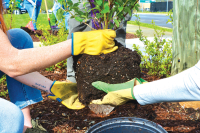Delving into the origin of Native American words
Editor’s note: This article was first published in The Smoky Mountain News in December 2003.
Tuckaseigee, Oconaluftee, Heintooga, Wayah, Cullasaja, Hiwassee, Coweeta, Stecoah, Steestachee, Skeenah, Nantahala, Aquone, Katuwah, and on and on. Our place names here in the Smokies region are graced throughout with evidence of the Cherokee culture that prevailed for over 700 years. Wouldn’t it be nice if Clingmans Dome was correctly designated as Mount Yonah (high place of the bears)?
A new, excitable girl in our quiet cove
Essays and columns are difficult to categorize. Dividing them into the formal and informal is about all anyone can agree upon, if that. In retrospect, I can see that this one is a fine example of a type within the informal category I think of as the “ramblin’ disquisition;” in other words, it doesn’t have a central theme (except that, for the most part, it’s about birds); and it wanders around … here and there … getting nowhere much until it ends of its own volition. You’ll see what I mean.
When frost comes, we know winter has arrived
The first frost serves as a given year’s most distinctive dividing line. It’s hard to pinpoint just when winter becomes spring, when spring become summer, or when summer becomes fall. But the winter season has arrived when the first frost occurs.
George Ellison releases new book, reflects on decades of life lived in nature
The Fourth of July, 1976, was just around the corner when George and Elizabeth Ellison embarked on a hike that would change their lives forever. The two were walking in the Great Smoky Mountains National Park when their wandering brought them to the park’s edge, a remote and beautiful cove with a bubbling stream flowing through it.
SEE ALSO: Ellison releases new title
Ellison releases new title
When George Ellison first started writing nature columns for the Asheville Citizen-Times back in 1986, it was with the assumption that, while he enjoyed such things, reader interest was likely limited and the column would be a short-lived venture. So, when the editor called him in to talk, Ellison was surprised to get not a polite goodbye but promotion to permanent status. The resulting column, “Nature Journal,” is still published today.
Come winter, trees reveal their blemishes
Like an old man’s face, mature hardwood tree trunks are covered with blemishes that signal age: cankers, seams, burls, butt scars, sterile conks, and protrusions in the form of bracket fungi. Winter is the time to take a closer look at this somber side of the natural world.
Witch-hazel has adapted as a late flowering plant
Editor’s note: this article first appeared in a November 2003 edition of The Smoky Mountain News.
If you take a walk along a woodland edge within the next few weeks, there’s every chance you’ll discover witch-hazel in full bloom. It sometimes flowers by early September and will persist into late December or early January during warm winters. But from early October into early November is the time to catch witch-hazel in its prime.
Robin redbreasts are a perennial favorite
Our elementary school primers were populated by robins pulling worms out of holes. They appeared on television screens on Saturday mornings, hopping about in Disney cartoons that represented “the idea of a bird.” We know what a robin looks like in outline, but do we know much about the real thing?
Bryson City and the widow Cline
Before the settlement named Charleston became the village named Bryson City in 1889, it was a tract of land known as Big Bear’s Reserve, which was itself located in the same general area as a Cherokee village that had been ravaged in 1761 by a British expeditionary force under the command of Col. James Grant.
Water was not always taken for granted
Old-time mountaineers often picked their home and church sites according to the location and purity of springs. They were connoisseurs of water.





